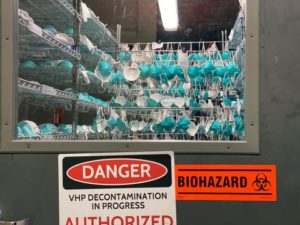In response to the COVID-19 pandemic, hospitals across the United States are disinfecting N95 masks by placing them in repurposed rooms or shipping containers injected with a disinfectant known as vaporized hydrogen peroxide. A new tool from the National Institute of Standards and Technology can help hospitals and medical professionals determine which rooms should be used to disinfect N95 masks. The tool estimates the amount of VHP masks would receive and suggests that larger rooms containing fewer objects, with less-reactive surfaces and slower ventilation, maintain VHP concentration the best.

“Hospitals have used VHP systems to disinfect isolation rooms after a highly infectious person has left,” said Andrew Persily, chief of NIST’s Energy and Environment Division. “Now there are efforts underway to do the same to disinfect masks.”
For hospitals, choosing and configuring rooms to house the N95 disinfection processes means accounting for conditions that vary from room to room, such as size, airflow and surface materials. These factors influence VHP concentration and, in certain cases, could prevent masks from receiving effective doses.
“Even if you’re hitting a room with a huge dose of VHP and you’re assuming it’s all going on your masks, a lot of it may be going on your walls or ceiling,” said Dustin Poppendieck, a NIST environmental engineer and the developer of the new tool. “Then you might not be disinfecting as effectively as you think.”
VHP’s interactions with various materials came into focus for Poppendieck in the early 2000s, before he joined NIST, when he studied the chemical’s ability to disinfect post office rooms containing anthrax-causing bacteria.
Those experiments revealed that VHP deposits onto certain surfaces much more readily than others. For example, tile floors consume much less VHP than does carpet, which can reduce the VHP concentration in a room by as much as 10 times.
Now, the data from those experiments has become the foundation of the new NIST tool — packaged into a spreadsheet — that models where VHP settles after being injected into a room.
By entering important parameters related to a room’s size, materials and ventilation into the spreadsheet, users get estimates of how much VHP would actually deposit onto the masks versus being lost through leaks or absorbed by surfaces, Poppendieck said.
The tool can help hospitals and other institutions make more informed decisions when choosing and adapting rooms for mask disinfection. However, it is not a one-stop shop, Poppendieck cautioned. Facility management, safety professionals and infection control experts would still need to work together to determine how to apply VHP safely and effectively.
“It should be a unified approach if you’re going to do this, and this tool is just one small piece of the puzzle to figure out how to appropriately disinfect masks using VHP,” Poppendieck said.





